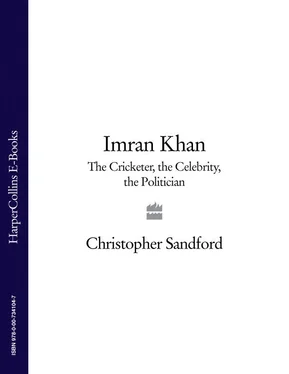In April 1984, the International Cricket Conference (ICC) gave its blessing to a triangular 50-over competition between Pakistan, India and Sri Lanka held in the Asian equivalent of Las Vegas, Sharjah. The venue was the newly opened 24,000-seat United Arab Emirates Association stadium, set in a vast tract of arid wasteland where Bedouin had roamed not long before. Alas, the cricket itself rarely lived up to the surroundings. But the tournament was significant nonetheless, because it was the first ICC-sanctioned series to employ exclusively ‘neutral’ umpires — umpires, that is, born and raised anywhere other than the three competing nations. From then on, this concept of non-aligned officials became something of a fetish for Imran. In October 1986, he persuaded the Pakistan board to appoint neutral umpires for the home series against the West Indies, to the evident satisfaction of both teams. Despite this initiative, the England authorities stubbornly resisted the temptation to assign two independent umpires to each Test for another 16 years. To Imran, for one, the delay was unconscionable, and could have only one explanation. ‘It reeks of colonial arrogance,’ he wrote. In the meantime his entire tenure as Test captain was punctuated by a series of umpiring controversies, often involving home officials such as Rana as well as English ones such as Constant. Highly debatable decisions, incredulous stares, on-field exchanges of pleasantries, calamitous press conferences, and spurious but widespread allegations of gambling, ball tampering and even food poisoning — these were the backdrop to the most successful career in Asian sports history.
The combustible world of Pakistan cricket was also frequently enlivened by charges of match-fixing, much of it reportedly centred on the ground at Sharjah. The ever voluble Sarfraz Nawaz would be neither the first nor the last player to go public with this particular allegation. But whether Sarfraz’s claim was deliberate or compulsive, there is no doubt the Pakistan team were affected by it. Although Imran himself was above reproach, he was made vividly aware of the rumours on a daily basis, chiefly by a Pakistani press never inclined to ignore or bury a good scandal. In fact some of the most lurid headlines on the subject came not in London but in Lahore and Karachi. It reached the point where in April 1990, at Sharjah, Imran felt compelled to gather his players together in the dressing-room before the start of play in a one-day international and have each of them swear on a copy of the Koran that none of them stood to gain by Pakistan losing.
The gladiatorial atmosphere in which Pakistan typically played their cricket also, perhaps not surprisingly, contained an element of crowd participation. In December 1980, Pakistan hosted a Test against the West Indies at Multan; Imran took five for 62 in the visitors’ first innings. Late in the match the West Indies bowler Sylvester Clarke, apparently aggrieved at being struck by an orange peel while fielding on the third man boundary, retaliated by throwing a brick into the crowd. It was an incalculably cretinous thing to do, but, even so, the response was somehow peculiarly Pakistani. A press photographer’s close-up of a victim of Clarke’s assault bleeding from a head wound was blown up and became a popular poster in bus and train stations throughout the country. Some time later, disgruntled students invaded the pitch in the course of a one-day match between Pakistan and India at Karachi. Imran, who was bowling at the time, calmly assessed the situation, removed a stump, waved it under the nose of the lead demonstrator and reportedly offered to impale him with it. After that there was a loss of interest on the student’s part in prolonging his stay on the field. Sometimes the source of the trouble was even closer to hand; at Perth, in November 1981, Javed Miandad became probably the first player to threaten to brain another one during a Test, after Dennis Lillee had kicked him. Lillee later admitted to having also given Javed some ‘verbal’, but insisted the Pakistani batsman had ‘overreacted’; a not unheard-of development.
For Imran Khan, the perennially embattled cricket superstar, a career in politics must have seemed almost tranquil by comparison. It’s rare for a player not only to operate at that level, in what he once called the ‘toxic’ atmosphere of Pakistan sport, but also to have graced the game in its every format around the world, chiefly in England. Although Imran took some time to find his feet in his adopted home, several good judges were left in no doubt, even then, that his arrival on the scene marked that of a major new talent. In July 1975, a 19-year-old Cambridge freshman named Alastair Hignell walked out to bat in the university match against Oxford at Lord’s. Hignell had been away on an England rugby tour of Australia until the eve of the game, and ‘therefore had no idea what to expect from the bowler ominously pawing at the ground before starting his run-up somewhere in the mid distance. Sure enough, it was a terrifying barrage … At one point, I took the wrong option and ducked into a bouncer which hit the fleshy part of my ear and ricocheted past the wicketkeeper in the direction of the pavilion. I was hoping for a single to fine leg to get off strike, so set off immediately. As it happened, the ball hit the boundary wall before the fielder could intercept it, but for some reason the umpire, John Langridge, didn’t bother tapping his leg for leg byes and instead signalled four runs … As I was trotting by I pointed out that the ball hadn’t hit my bat, but had bounced off my ear which by now was red, swollen and throbbing painfully. “Listen, sonny,” he muttered out of the corner of his mouth, as Imran again limbered up in the distance. “You’re not going to be here long, anyway. You might as well take all the runs you can get.”’
*For the statistically minded, 83.3 per cent of the Tests Pakistan played under Imran’s captaincy thus ended in a win or a draw; Mike Brearley, widely regarded as the Freud of modern Test captains, scored 89.5 per cent, while for Imran’s contemporary Ian Botham the figure falls to 66.6 per cent.
*Reflecting on the incident, the veteran journalist Antao Hassan told me that ‘It was really a question of what’s now called ageism’; Saeed was already 31 when he was dropped — ‘virtually senile’ in a national cricket culture that puts an extreme premium on youth.
*David Constant declined to comment on his feelings, if any, about Imran when I contacted him in 2008. However, Constant’s sometime colleague Dickie Bird was happy to oblige. He told me that in his experience Imran had ‘play[ed] within the spirit and the law’ of the game, and that he had ‘never had a problem with him’.
Конец ознакомительного фрагмента.
Текст предоставлен ООО «ЛитРес».
Прочитайте эту книгу целиком, купив полную легальную версию на ЛитРес.
Безопасно оплатить книгу можно банковской картой Visa, MasterCard, Maestro, со счета мобильного телефона, с платежного терминала, в салоне МТС или Связной, через PayPal, WebMoney, Яндекс.Деньги, QIWI Кошелек, бонусными картами или другим удобным Вам способом.












